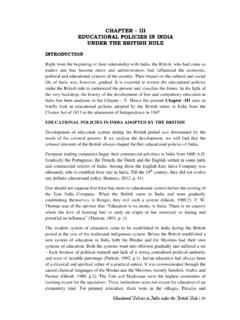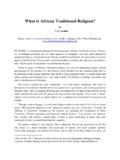Transcription of Religion and Higher Education: The Good, the Bad, and the …
1 Religion and Higher education : The Good, the Bad, and the Ugly By Darren E. Sherkat Published on: Feb 06, 2007. Darren E. Sherkat serves as chair of the sociology department at Southern Illinois University, Carbondale. His research interests include the sociology of Religion , social movements and collective behavior, statistics and methods, medical sociology and contemporary sociological theory. Religion is a hot button topic in Higher education , as it is in many areas of the provision of public goods. Scholars and administrators are noticing that our students are more religious than previous generations of college students, though they don't have a clear sense of why.
2 Some studies claim that religious students are better students and there is some merit to this argument. Religion does provide students with healthy alternatives to other social engagements. Yet, studies of elite and residential college populations fail to take into account the larger picture; since Religion , and especially fundamentalist Christianity, can have a negative effect on going to college. While some religious factors have a positive impact on college success, other religious commitments undermine educational attainment (Darnell & Sherkat 1997; Glass & Jacobs 2005; Lehrer 2004, 1999; Sherkat & Darnell 1999). Once in college, religious factors can also play a role in the trajectory of study, impacting the choice of major, courses taken, and successful completion.
3 Importantly, religious factors also influence the context of contemporary Higher education . Increasing rates of college attendance in the general population has also meant that more members of predominately fundamentalist Christian sects, who almost uniformly eschewed Higher education in previous generations, are now living in the same dormitories with liberal Protestants, Catholics, Jews, and an increasingly diverse array of non-Christians. It is important to briefly outline the contours of American Religion , and define some sociological terms which may differ from their common usage. Sect is a term describing religious groups holding the belief that religious rewards (heaven, nirvana, etc.)
4 Will exclusively fall to adherents of the sectarian faith everyone else will receive punishment from the gods, or at least no rewards. This orientation often creates tension with other religious groups and broader society (Stark and Finke 2000). In the United States, the majority of sectarian organizations are Christian, including groups like the Southern Baptists, Assembly of God, Nazarene, and Churches of Christ. Liberal and moderate Christian denominations (such as Episcopalians, Presbyterians, Lutherans, Methodists, United Church of Christ, and Disciples of Christ) tend to be less exclusive in their beliefs about religious rewards and punishments. Of course, there are liberalizing movements within sectarian denominations, and sectarian movements within liberal denominations (Stark & Bainbridge 1987).
5 Among General Social Survey (GSS, 2000-2004) respondents age 25 or under, 19% were raised in liberal or moderate Protestant denominations, while 25% were raised in sectarian groups. 31% of college-aged persons were raised Catholic, 3% grew up in non-Christian faiths (1% were Jewish, college-aged persons were raised Catholic, 3% grew up in non-Christian faiths (1% were Jewish, the rest mostly Moslem, Hindu, and Buddhist), and 13% reported not being raised in a religious faith. Looking back at previous generations, reveals a profound shift in religious origins: 29% of GSS respondents born between 1940 and 1945 grew up in liberal or moderate Protestant groups, while 26% were reared in sectarian Protestant churches, and only 3% were raised without a religious affiliation.)
6 Fundamentalism is a religious orientation of individuals or groups that values sources of meaning derived from the sacred texts of a religious tradition (Hood, Hill, & Williamson 2005). Religious fundamentalism is found in movements and among individuals from all types of religious traditions (Cole 2002; Hood, Hill, & Williamson 2005). Among Christians, an excellent measure of fundamentalism is belief in the inerrancy of the Bible. General Social Survey data show that among those who hold a sectarian affiliation, about 60% have fundamentalist orientations, while 30% of mainline affiliates and 21% of Catholics adhere to fundamentalist beliefs (Sherkat 2007). Religious fundamentalism is somewhat less prevalent among younger members of sectarian denominations, GSS data show that 50% of sectarian Protestants age 25 or under hold fundamentalist beliefs.
7 Most accounts of religious trends tend to ignore the basic demographic processes which often explain religious dynamics (Hout, Greeley, & Wilde 2001). Students are more involved in Religion , and current college students are more committed to sectarian religious groups. Several things have happened. First, over the last five decades there has been a dramatic increase in the proportion of the American population who attend college. Because sectarian groups and Catholics have Higher rates of fertility, the average age of sect members is much lower than the average age of members of mainline religious groups (Roof and McKinney 1987; Sherkat 2007). As a consequence, the available pool of students is now more heavily comprised of sectarian affiliates and Catholics, and both of these groups have high levels of religious commitment when compared to mainline Protestants.
8 Second, the proportion of African Americans and women earning college degrees has increased dramatically many universities currently have more women seeking degrees than men. This simple fact has a profound impact on the religiosity of college campuses, since African Americans and women are substantially more religious than men and Anglo Americans (Miller & Stark 2002;. Sherkat 1998, 2007). Young men have the lowest levels of religious commitment of any demographic group, and they dominated college campuses until the late 20th century. African Americans have also brought an expressive form of sectarian Christianity to college campuses, and the visibility of largely African American religious practices at sporting events has caused concern in many venues.
9 The arrival of women and African Americans has infused Religion into the core of everyday activities of campus life. When women were a small minority and African Americans were confined to segregated institutions, campus Religion could only be sustained by using paid chaplains serving an ecumenical group of mostly liberal Protestants. Catholic colleges enforced religious participation by making it mandatory. Now, college religious institutions are more diverse, more sectarian in affiliation, more fundamentalist in orientation, and are more often led by students and outside ministries like the Campus Crusade for Christ. Third, a large proportion of degrees are now earned by non-traditional students.
10 Compared to previous generations, current students are older, more likely to be married, more likely to have children, and to work outside of school. Older students will be more settled into religious participation. People who are married and who have children are more likely to be active members of religious groups (Myers 1996; Stolzenberg et al 1995; Sherkat 1998). In my experiences in the classroom, I have found that older students tend to be more vocal about religious commitments and other political, economic, and even personal issues. The aging of the undergraduate population certainly makes religious issues more visible on campus. Normal demographics explain much of the current trend toward religiosity among college students, and they may also explain a substantial portion of the positive relationship between religious participation and educational outcomes.









